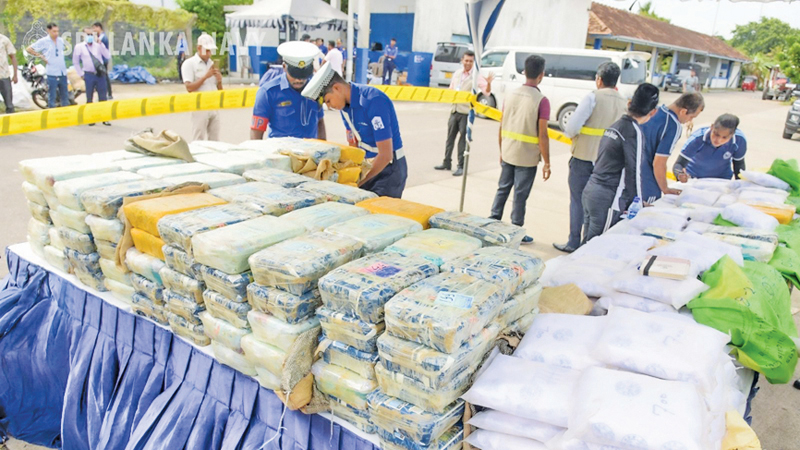Campaigns like “Mathata Thitha” and “Operation Yukthiya” created headlines in the past with a high number of arrests, but with an obvious lack of genuine political will to tackle the roots of the drug crisis, they were losing battles from the start, meant to impress on the surface rather than create meaningful change.
When politicians accused of drug deals and crime, from Ministers to local councillors, walked free, shielded by political connections, a palpable disgust built among the public. The continued patronage and asylum for hardened criminals and drug barons led to eroding public confidence in the legal system.
The public have high hopes on the current administration led by the National People’s Power (NPP) to break this cycle and free the country from the drug menace. The Police say the three most pressing issues facing the country today are drug abuse, road accidents, and crimes against children and women.
The range of drugs available to consumers has expanded over time, making patterns of use increasingly complex and polydrug use a common feature. Cannabis has long been used as a drug, while heroin began to appear in Sri Lanka around 1981. Methamphetamine, widely known as ICE, emerged in 2005, and in more recent years, various forms of drug pills have also entered the local drug scene.
From urban centres to rural communities, the grip of narcotics has been deeply troubling, drawing more victims, especially the young, into cycles of addiction and crime. Illicit drugs are a major social, health, and economic burden on the country.
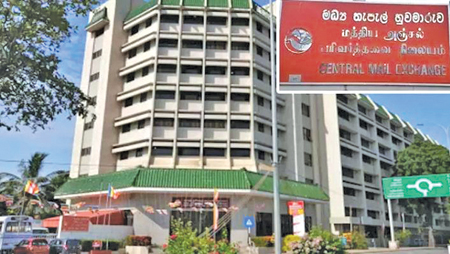
Drug traffickers increasingly exploit the Central Mail Exchange (CME) to smuggle drugs
The numbers speak volumes. Acting Inspector General of Police (IGP) Priyantha Weerasooriya told a media conference last week that since the new Government took office on September 23, 2024, 1,253 kg of heroin and 2,121 kg of crystal methamphetamine (ICE) have been seized. The Police have also confiscated 12,491 kg of cannabis, 22 kg of cocaine, and 1.6 million drug pills, during the same period.
“Despite the raids, drugs continue to circulate widely in society. Enforcement alone cannot solve the problem, reducing demand is equally critical. To achieve lasting results, active public cooperation and community involvement are essential,” said the acting IGP.
It is in this context that Sri Lanka marked the International Day Against Drug Abuse and Illicit Trafficking on Thursday (26), aligning with the United Nations Office on Drugs and Crime (UNODC) theme “The evidence is clear: invest in prevention” and the campaign slogan “Break the cycle. #StopOrganisedCrime”.
The national event was held at Independence Square with a walk that brought together key stakeholders in the fight against drugs, including the National Dangerous Drugs Control Board (NDDCB), Police, Navy, Coastguard, National Authority on Tobacco and Alcohol (NATA), Bureau of Rehabilitation, school communities, public servants, private sector representatives, and international organisations.
According to global statistics, almost 316 million, or 1 in 17 people aged 15 to 65, used a drug in the year 2023, a 28 percent increase compared to a decade earlier. The UNODC’s ‘World Drug Report 2025’, launched last Thursday, said that around 64 million people were suffering from drug use disorders in 2023.
Injecting drugs

Public Security and Parliamentary Affairs Minister Ananda Wijepala
“An estimated 14 million people injected drugs in 2023. People who inject drugs constitute one of the main drivers of new HIV and hepatitis C infections,” the Report said.
The UNODC identifies a lack of connection to family or community, instability, insecurity, trauma, poor parenting, negative social norms, peer or familial drug use, mental health issues, conflict and violence as underlying conditions contributing to drug use.
Public Security and Parliamentary Affairs Minister Ananda Wijepala told the media that, based on current estimates, there are around 400,000 drug addicts in the country. The Minister said that the authorities have begun responding the issue with greater urgency. From large-scale drug seizures and arrests to expanded rehabilitation services and community awareness programs, he said that the Government is investing both money and manpower to tackle the crisis with the seriousness it demands.
“The NPP-led Government is committed to make the country free of drugs, as promised in its election manifesto. Unlike the showy, superficial actions of previous Governments, we have taken practical steps to prevent drugs from entering the country. People who were once hesitant to share information are now coming forward,” said the Minister, adding that law enforcement authorities have seized nearly two tonnes of heroin and ICE in the past five months alone.
Rising synthetic drug use
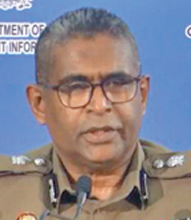
Acting IGP Priyantha Weerasooriya
There are concerns that Sri Lanka has become a transit country for drugs, mostly originating from Afghanistan, Pakistan and India, en route to wealthier markets. Recent open-ocean drugs seizures indicate a rise in maritime trafficking.
The authorities have flagged drug trafficking through the Central Mail Exchange (CME) an emerging trend, with increasing instances of narcotics being smuggled via postal and courier services. “Criminal networks are exploiting these channels to transport illicit substances such as methamphetamine tablets, marijuana, and hashish, often concealed in packages and parcels. This reflects the increasing sophistication of traffickers in evading traditional law enforcement methods,” the NDDCB’s ‘Handbook of Drug Abuse Information in Sri Lanka 2024’ said.
Law enforcement agencies seized 83 kg of ICE drugs in 2023, while arresting 26,096 persons. The notable presence of ICE-related offences points to the growing threat of synthetic drugs in the country. The prevalence of ICE-related arrests among the 15-64 age category stands at 128 persons per 100,000 of the population, the Handbook added. Young people have been identified as a high-risk group for synthetic drug use, due to factors such as peer influence, easy access to newer synthetic drugs and a desire for enhanced performance, the ‘World Drug Report 2024’ said.
NDDCB Chairman Dr. Indika Wanninayake said the Precursor Control Authority (PCA) oversees 23 types of chemicals, known as precursors, imported and used in Sri Lanka. Precursors are generally used in various industries for licit purposes. However, drug traffickers often divert them illegally to manufacture dangerous synthetic drugs like ICE. Sri Lanka does not produce these chemicals locally, so they are all brought in from abroad.
Investing money and manpower
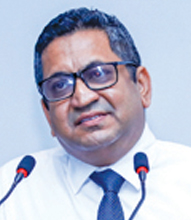
NDDCB Chairman
Dr. Indika Wanninayake
“We are working to dismantle organised drug networks. Over 1,000 suspects have been arrested. At the same time, the Government has increased funding for prevention programs, allocating approximately Rs. 950 million under the ‘Clean Sri Lanka’ initiative. Currently, four rehabilitation centres are operational. Our aim is to establish at least one rehabilitation centre in each province by the end of this year,” Minister Wijepala said.
He added that Public Safety Committees have been established in every Grama Niladhari division, with one of their core responsibilities being the prevention of drug-related offences. This initiative aims to ensure close coordination with the public. “Last year, there had been around 1,000 community awareness sessions. This year, we have planned 6,125 programs, of which about 2,000 have already been completed, prioritising schoolchildren, teachers, and parents,” said the Minister.
The NDDCB Chairman said that the ‘1927’ hotline operates round the clock for those seeking information on professionals and institutes offering treatment and counselling for drug-related matters.
The Police Narcotic Bureau regularly analyses drug price trends in both wholesale and retail markets. In 2023, cocaine was identified as the drug with the highest retail street-level price, reaching Rs. 27.5 million per one kilogram, while one kilogram of heroin and methamphetamine was Rs 17.5 million and Rs 17 million respectively. Cannabis was reported to have the lowest street-level price at Rs. 160,000, also reflecting its relatively higher availability, the NDDCB’s Report said.
Cannabis remains by far the world’s most commonly used drug. Cannabis, however, without its narcotic content, is used in the manufacture of Ayurveda medical preparations in Sri Lanka. Hence the Ayurveda medical practitioners and the Ayurvedic Drug Corporation was the largest consumer of cannabis. Over 1,200 kg of cannabis were used for Ayurvedic medicinal purposes in 2023.
Substance abuse and criminal behaviour are intricately linked. In 2023, 673 crime cases were reported as being influenced by drugs. Among these were housebreakings, robberies, grievous hurt, knife-related harm and homicides.
Women’s involvement
The NDDCB Report highlighted a noticeable increase in female prison admissions for narcotic offenses between 2019 and 2023. “This rising trend reflects a growing involvement of women in drug-related activities, whether as users or dealers. The increase in admissions underscores the necessity of developing gender-sensitive approaches within the criminal justice system to effectively manage and rehabilitate women involved in narcotic offenses,” it added.
The UNODC’s Report said that drug-related treatment coverage is lower among women than among men. “Some one in 18 women with drug use disorders received treatment globally in 2023, while the ratio was one in seven in the case of men. Women account for approximately one in four people who used a drug in the past year.
“However, when it comes to the non-medical use of pharmaceutical drugs such as sedatives and tranquillisers, pharmaceutical opioids or stimulants, the share of women using these substances could be substantially higher and, in some cases, nearly equal to those of men. Women also continue to face disproportionate barriers in accessing drug treatment and services, such as a lack of awareness, stigma, a lack of gender-specific facilities and financial constraints,” the Report said.
In responding to drug use, it is equally important to consider those surrounding the person, especially children and family members, and ensure their health and wellbeing are supported as well.
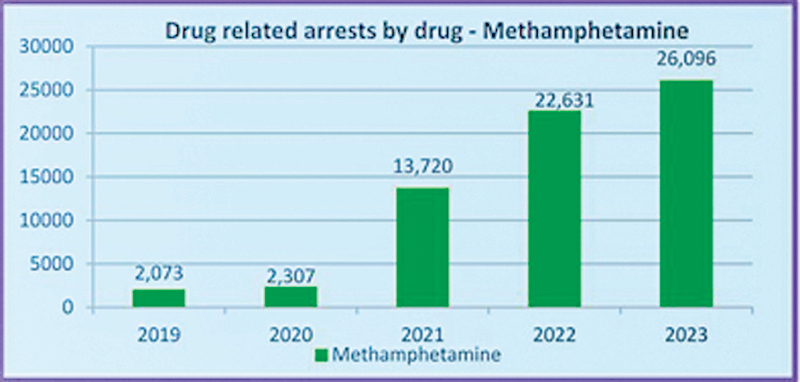
The ICE-related offences have been growing






